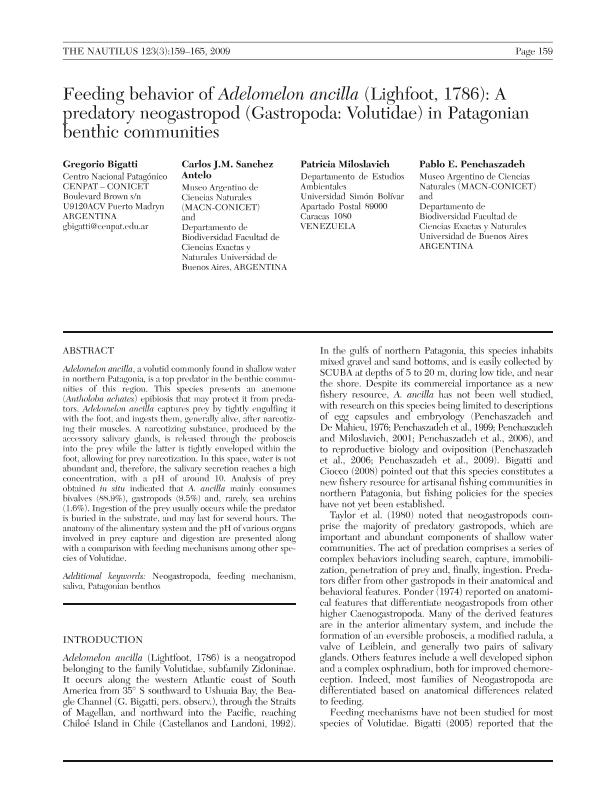Artículo
Feeding behavior of Adelomelon ancilla (Ligfoot, 1786): A predatory neogastropod (Gastropoda: Volutidae) in Patagonian benthic communities
Fecha de publicación:
06/2009
Editorial:
Bailey-Matthews Shell Museum
Revista:
The Nautilus (Philadelphia)
ISSN:
0028-1344
Idioma:
Inglés
Tipo de recurso:
Artículo publicado
Clasificación temática:
Resumen
Adelomelon ancilla, a volutid commonly found in shallow water in northern Patagonia, is a top predator in the benthic communities of this region. This species presents an anemone (Antholoba achates) epibiosis that may protect it from predators. Adelomelon ancilla captures prey by tightly engulfing it with the foot, and ingests them, generally alive, after narcotizing their muscles. A narcotizing substance, produced by the accessory salivary glands, is released through the proboscis into the prey while the latter is tightly enveloped within the foot, allowing for prey narcotization. In this space, water is not abundant and, therefore, the salivary secretion reaches a high concentration, with a pH of around 10. Analysis of prey obtained in situ indicated that A. ancilla mainly consumes bivalves (88.9%), gastropods (9.5%) and, rarely, sea urchins (1.6%). Ingestion of the prey usually occurs while the predator is buried in the substrate, and may last for several hours. The anatomy of the alimentary system and the pH of various organs involved in prey capture and digestion are presented along with a comparison with feeding mechanisms among other species of Volutidae.
Palabras clave:
NEOGASTROPODA
,
FEEDING MECHANIS
,
SALIVA
,
PATAGONIAN BENTHOS
Archivos asociados
Licencia
Identificadores
Colecciones
Articulos(MACNBR)
Articulos de MUSEO ARG.DE CS.NAT "BERNARDINO RIVADAVIA"
Articulos de MUSEO ARG.DE CS.NAT "BERNARDINO RIVADAVIA"
Citación
Bigatti, Gregorio; Sanchez Antelo, Carlos; Miloslavich, Patricia; Penchaszadeh, Pablo Enrique; Feeding behavior of Adelomelon ancilla (Ligfoot, 1786): A predatory neogastropod (Gastropoda: Volutidae) in Patagonian benthic communities; Bailey-Matthews Shell Museum; The Nautilus (Philadelphia); 123; 3; 6-2009; 159-165
Compartir




